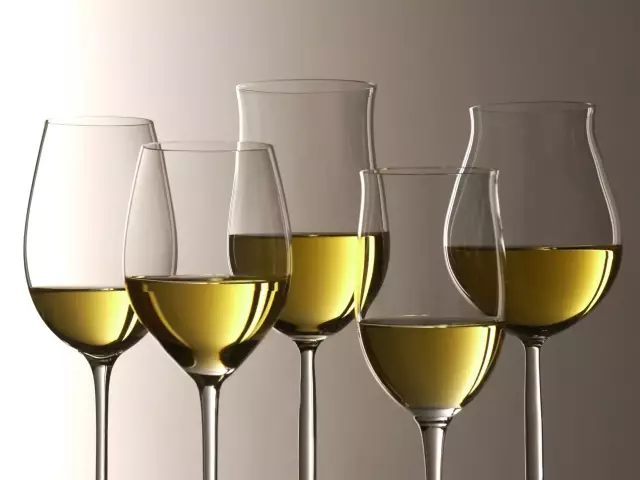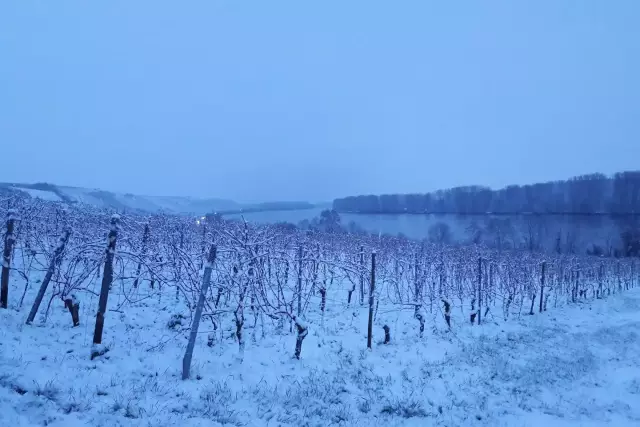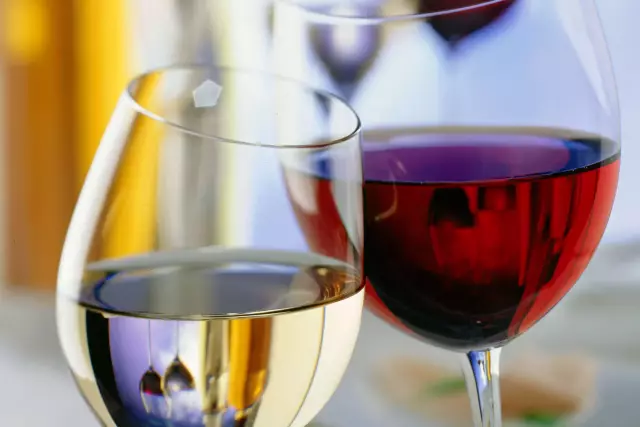Wine Crystals

To set the record straight: tartrate crystals in wine, known as "Weinstein" in German, are neither harmful nor a sign of poor quality; on the contrary, they are characteristic of wines that are rich in minerals.
Tartrate Crystals – a feature of fine wine
While tartrates can crystallize in young wines, they are most likely to precipitate in older, top-quality wines, such as Auslese, Beerenauslese or Trockenbeerenauslese. The tiny crystals that form on the bottom of the cork or on the sides of the bottles are the mark of a wine that has had the benefit of long bottle aging.
Layers of tartrate deposits slowly develop on the walls of wine barrels, too. When illuminated, the interior of an old cask resembles an icy cave full of glistening crystals.
How do Crystals Develop in Wine?
Riper grapes have higher levels of tartaric acid. The longer grapes ripen on the vine, the longer they have to absorb minerals from the soil. Little by little crystals can develop when these minerals come into contact with tartaric acid. Rather than dissolving in the wine, they precipitate and form a deposit on the sides or bottom of the bottle, on the cork, or on the inside of the barrel.
Crystals in the Bottle – More Aroma in the Wine
Although tartrate crystals do not influence the quality of a wine, there is an interesting correlation between the two. Slow fermentation at low temperatures helps conserve a wine¹s aroma compounds. It also results in tartrate deposits developing later, in the bottle, rather than while the wine is still in the barrel. As such, crystals can be regarded as the mark of a good winemaker and a wine of quality.
Another kind of wine crystal
Fine, almost dust-like crystals are sometimes found in high-quality Auslesen, Beeren- and Trockenbeerenauslesen or ice wines. However, this is usually not tartaric crystals in the proper sense, but natural calcium salts that have precipitated due to higher storage temperatures. In addition, a so-called deposit often forms in rich and tannin-rich red wines. This rather powdery, dark-colored sediment is created from tannins and pigments that combine with age and sink to the bottom.
Neither these nor the tartaric crystals harm the wine in any way and do not reflect the quality. It is more of an aesthetic issue that it is not desirable in the glass. Pouring the wine gently leaves the tartar in the bottle. In the case of red wines, decanting beforehand helps - ideally in front of a light source, which makes it easy to see whether the sediment remains.
topical page: quality standards
topical page: grape varieties
What is "gushing" and what role do tartrate crystals play in it?
Tartrate can become a problem in carbonated beverages and especially in sparkling wine, as it offers many so-called condensation nuclei for the carbonic acid. It is released at these points and extreme foam development occurs - gushing.
Varietals

More recipe ideas
with semi-frozen goat's milk Lavender waffles
with semi-frozen goat's milk
- 2 Stück Eigelb
- 60 ml Ziegenmilch
- 500 Gramm weiße Kuvertüre
- 125 ml Sahne
- Abrieb und Saft einer halben Orange
- 2 cl Tresterbrand
- 8 Blatt Minze
- 125 Gramm Mehl
Semi-frozen goat's milk: Beat the egg yolks and goat's milk in a bowl over a hot bain-marie until creamy. Remove from the bain-marie and beat the cream until cold. Flavour with the zest of the orange and the marc brandy.
Liquefy the couverture in a bain-marie and stir into the lukewarm egg mixture. Whip the cream until stiff and carefully fold in. Line a parfait tin (triangular or gutter shape) with cling film. Pour in the mixture and smooth out. Cover well with cling film and leave to freeze in the freezer for at least 8 hours.
About 20 minutes before serving, remove the mould from the freezer and turn the parfait out of the mould. Remove the foil and cut the semi-frozen parfait into 8 slices.
<p
<p>Lavender wafers: Lightly mash the butter in a mixing bowl with a fork. Add the sugar and stir a little. Add half of the milk, the lavender sugar and the baking powder. Stir in the eggs and finally the rest of the milk. Mix everything well with a hand mixer for about 2 minutes to create a homogeneous, slightly liquid mixture. Bake the batter in batches in a waffle iron until golden brown.</p
<p>Arrange 2 slices of semifreddo on each waffle on a flat plate and decorate with mint leaves.
- Riesling (halbtrocken & feinherb)
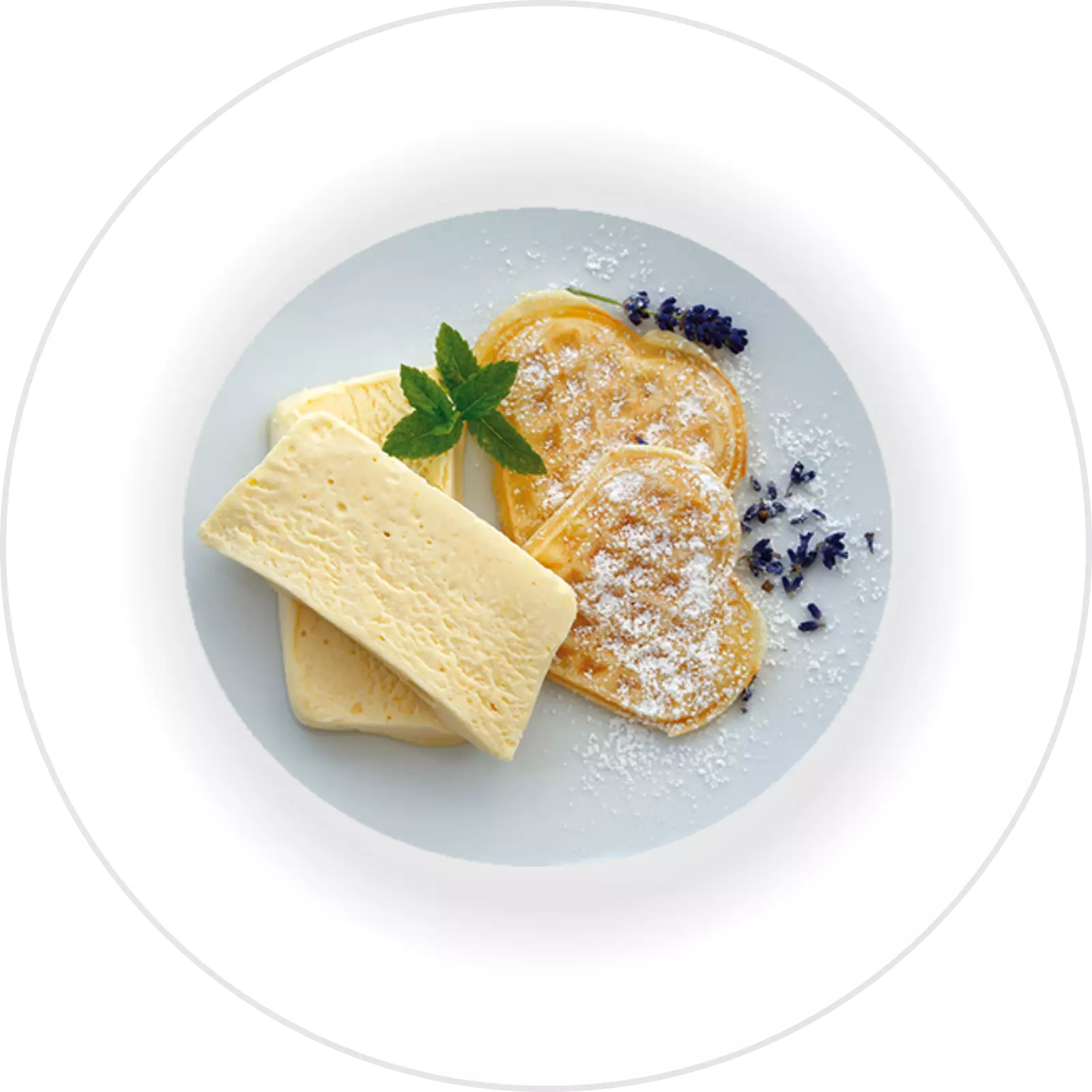
with apples Pork medallions
with apples
- 8 Stück Schweinemedaillons
- 500 Gramm Bandnudeln
- 2 große Äpfel
- 200 ml Sahne
- 10 Blättchen frischer Salbei
- 4 Zweige frischer Thymian
- nach Geschmack Zucker
- 3 EL Calvados
- 1 EL Öl
- zum Abschmecken Salz & Pfeffer
Slightly pepper and salt the medallions on both sides. Pluck the thyme, cut the sage into fine strips and roll the medallions in the herbs. Fry the meat in a pan with a little oil on both sides, not too hot, until it starts to colour. Remove from the pan and place on a preheated tray in the oven at 100 °C until cooked through.
Cook the tagliatelle al dente and keep warm.
In the meantime, peel the apples and cut into slices approx. 1.5 cm wide. Reheat the meat pan and add the apple slices. After about half a minute, sprinkle 1 teaspoon of sugar over the apples and allow them to caramelise. After a minute, deglaze the apple slices with a generous dash of Calvados and flambé. Add the cream and flavour with salt and pepper.
Remove the fillet from the oven. Add the meat juices from the oven dish to the sauce and serve the fillets with the tagliatelle, apple slices and Calvados apple sauce.
<p- Riesling (trocken)
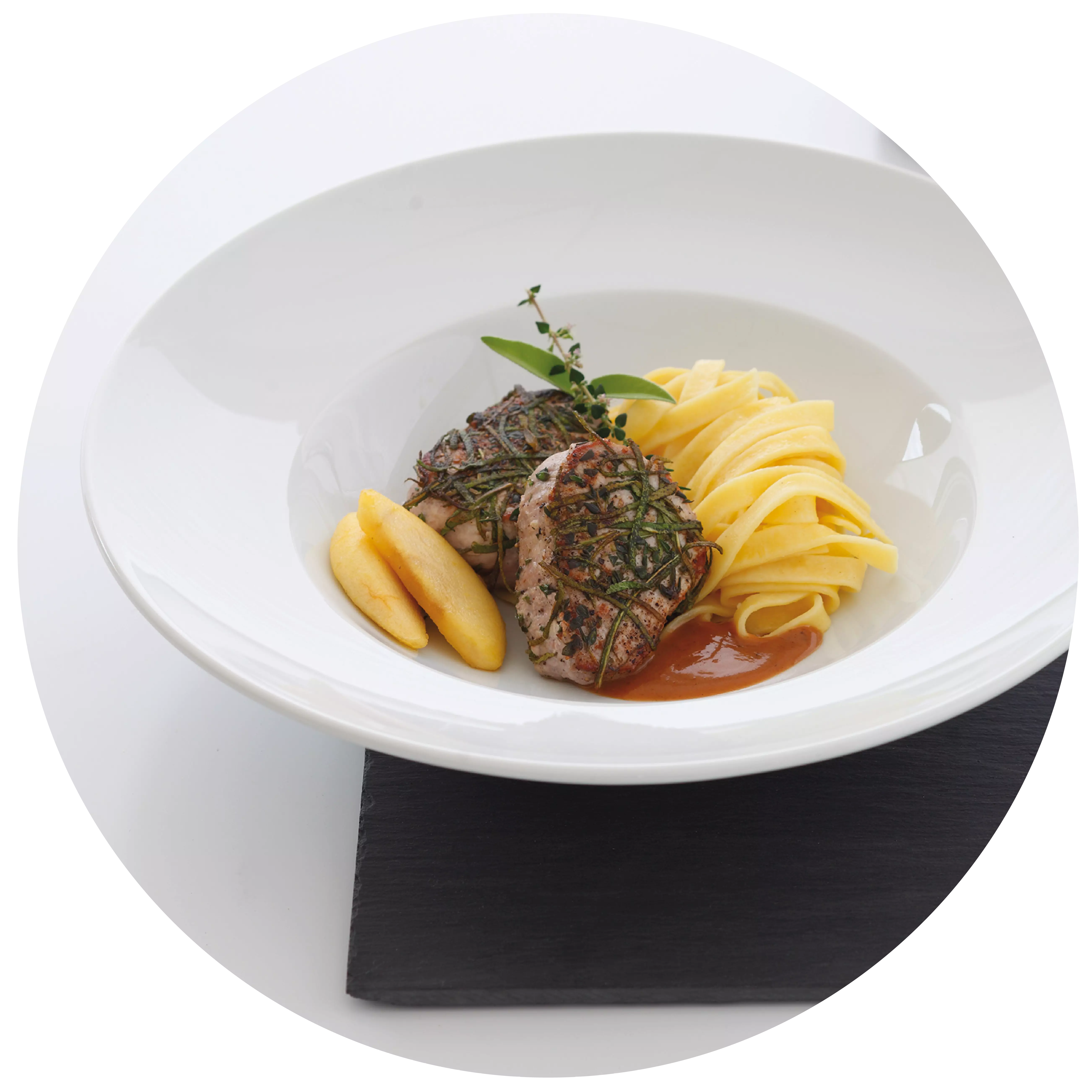
Japanese hollandaise succeeds with wasabi paste Salmon with Japanese hollandaise and green asparagus
Combine salmon with hollandaise and asparagus with a dry Riesling.
- 4x 150g Lachsfilet mit Haut
- 1 Limette
- 2 Zehen Knoblauch
- 4 EL Honig
- 10 EL Sojasauce
- 200g Butter
- 4 Eier
- 1 EL Joghurt
- 2 EL Reisessig
- 2 EL Wasabipaste
- 500 g Grüner Spargel
For the marinade, finely chop the garlic first. Wash the lime in hot water, grate the zest and squeeze out the juice and bring everything to the boil with the honey and soya sauce. Put to one side.
Now prepare the Japanese hollandaise: Bring 180g butter to the boil. Place the egg yolks, yoghurt, rice vinegar, wasabi paste and a pinch of salt in a tall measuring jug and mix with a hand blender. Gradually mix the boiling (!) butter into the egg yolks using a hand blender. Season the hollandaise with salt and pepper to taste and keep the measuring jug warm in hot water.
Peel the bottom third of 500 g green asparagus and cut off the ends. Melt 1 tbsp butter in a large pan. Add the asparagus to the pan, pour in 50 ml water and season with salt and pepper. Cover and bring to the boil briefly.
Fry the salmon fillets on the skin side in a little oil for about 4 minutes. Turn the salmon and fry for a further 2 minutes. Then turn again and baste with the marinade. Remove the salmon from the pan and reduce the marinade until thick. Brush the salmon with it. Serve the salmon with the hollandaise and asparagus. Enjoy your meal!
Wine recommendation:
WINE TIP: Dry Rielsing
- Riesling (trocken)
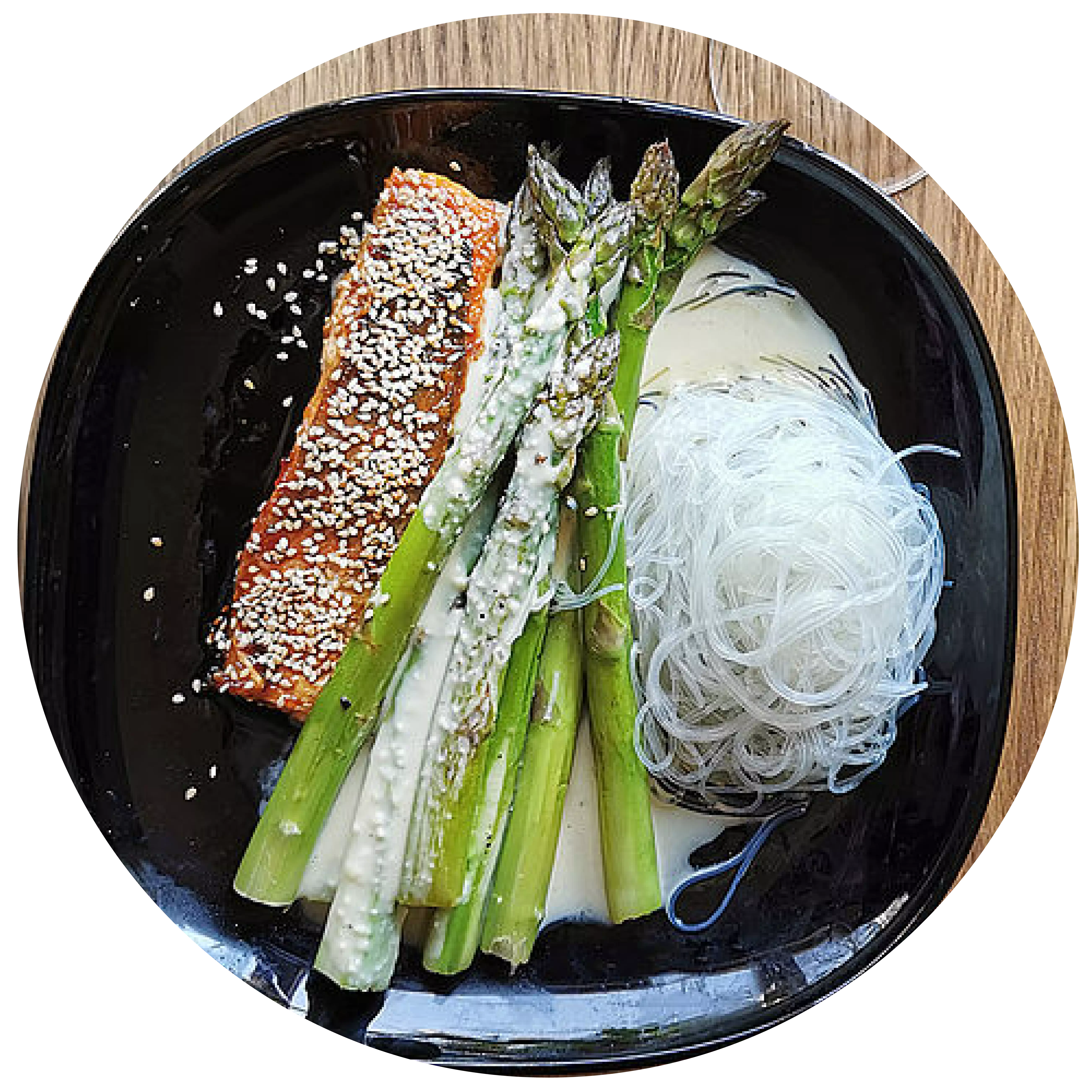
in a bacon coating Lamb
in a bacon coating
- 4 Stück Lammlachse à 150 g
- 4 Scheiben Bacon
- 0,1 Liter Wein
- 0,3 Liter Gemüsebrühe
- 1 kleine Schalotte
- 20 Gramm Butter
- 4 EL Olivenöl
- je 2 Zweige Thymian, Rosmarin, Salbei
- nach Geschmack Salz & Pfeffer
Season the lamb salmon with pepper and massage 2 tbsp of olive oil into the meat. Finely chop the thyme, rosemary and sage and season the meat in the herbs. Marinate in the fridge for a few hours.
<p
<p>Wrap the meat with the bacon slices and sear on all sides in the remaining olive oil. Continue to cook for approx. 4 minutes on each side over a low heat (the cooking time depends on the thickness of the lamb loin - it is best to do a pressure test). Then wrap in aluminium foil and leave to rest in the oven at 80 °C – so they remain juicy and slightly pink on the inside.
This goes well with Bärlauch risotto.
- Dornfelder (trocken)
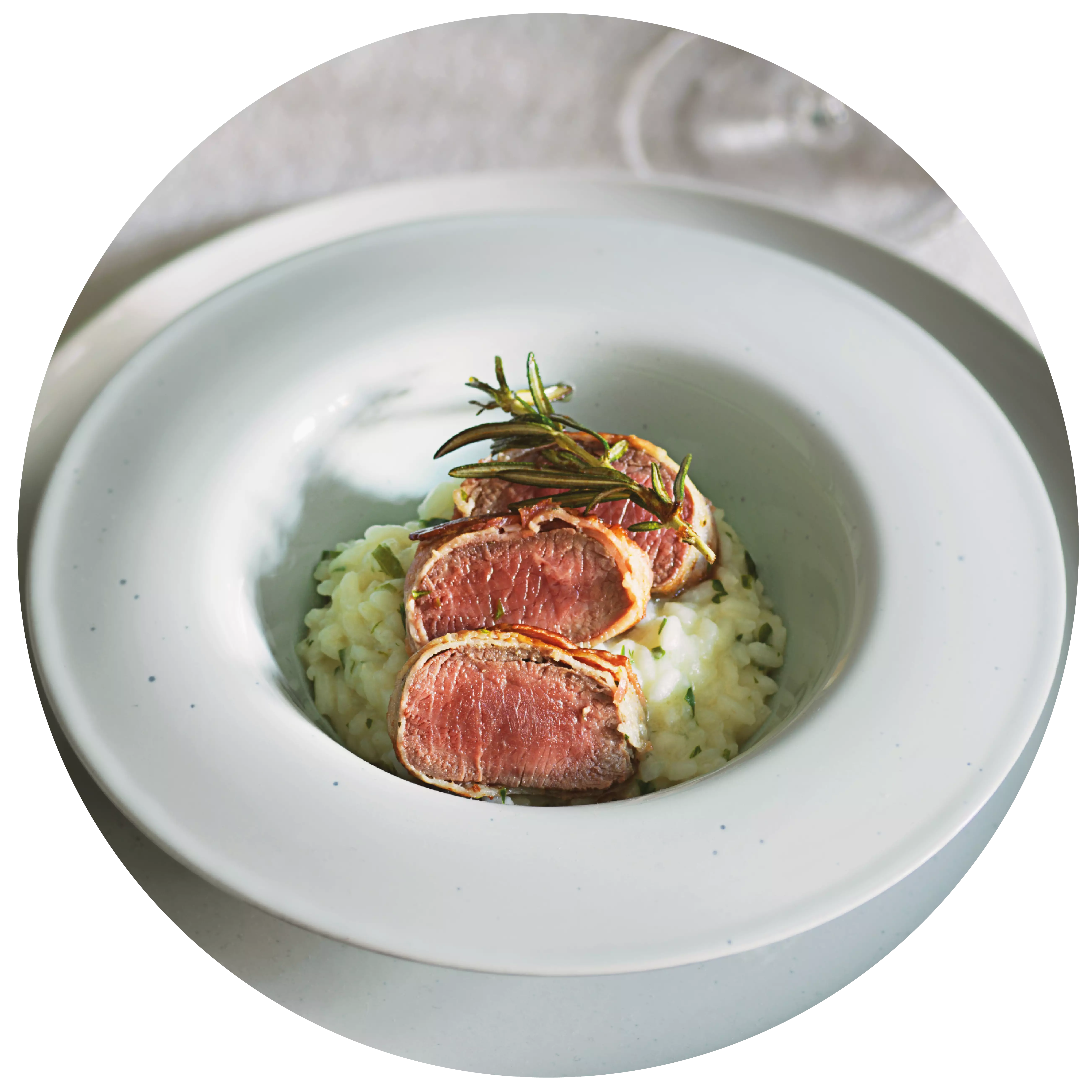
Events
-
Show
winetasting in our winery - blind tasting
Mainz-Hechtsheim


